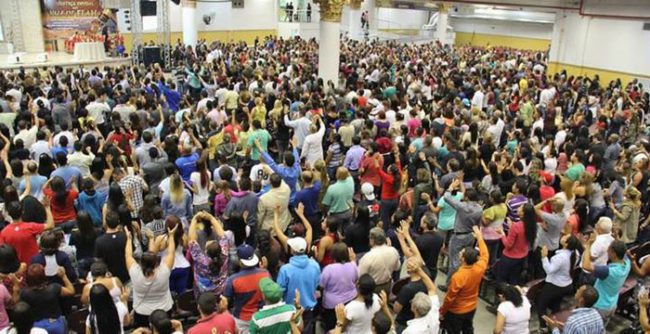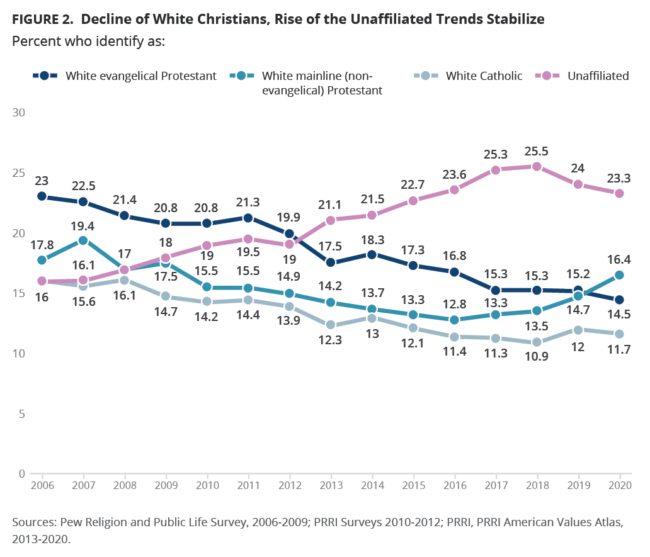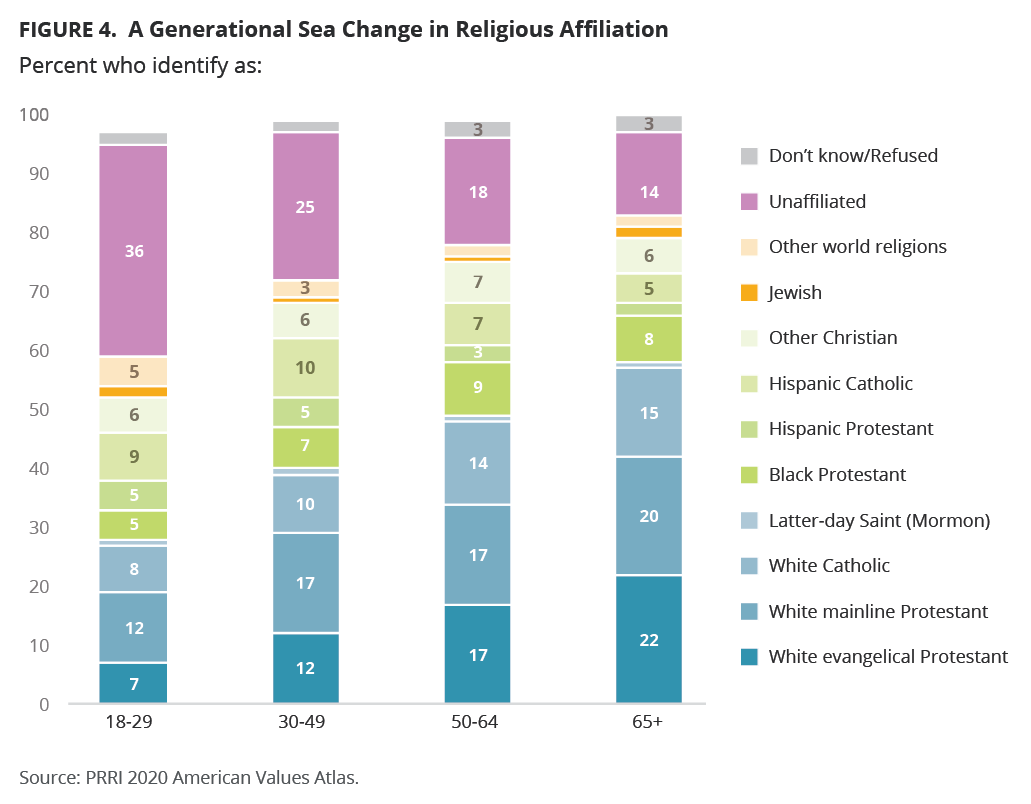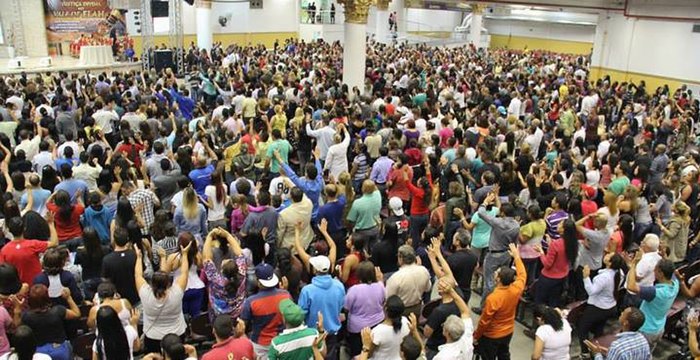
PRRI (Public Religion Research Institute), released the details of a major census of religion in the US on July 8th. There is a great deal of detail contained within it. This is perhaps to be expected because it has been based upon interviews conducted with more than 500,000 respondents between 2013 and 2020. Here I’m I’m going to focus down upon one demographic – the evangelicals.
Key Highlight – Steep Evangelical Decline
As recently as 2006, white evangelicals were 23% of the US population. This new poll reveals that they have dropped by an astonishing amount and are down to just 14% in 2020.
Let me spell that out.
Just 15 years ago almost 10% of the entire US population, that’s roughly 33 million evangelicals, have today walked away from that specific religious brand.
Here is a chart that illustrates this …

Since 2006, white evangelical Protestants have experienced the most precipitous drop in affiliation, shrinking from 23% of Americans in 2006 to 14% in 2020. That proportion has generally held steady since 2017 (15% in 2017, 2018, and 2019).
Where have all these Evangelicals Gone?
It’s complicated, and multiple factors are most probably in play here. Polls just report numbers, they don’t explain why. To fill that gap here is some speculation from me.
For the above chart one big ongoing trend is that as the evangelicals have declined, the number of nones (not religiously affiliated) has increased. What I suspect may be in play there is that as the older more religious generations pass away, they are being replaced by an upcoming far less religious generation. This is the generation that has grown up with the internet and so have not been totally isolated inside religious bubbles. They have been exposed to other ideas that challenged traditional beliefs and so doubt took hold.
Beyond those big curves, there is also an interesting smaller trend. Notice how over the last couple of years an uptick of non-evangelical white Protestants has mirrored the white evangelical downwards trend. This may be the Trump effect. If somebody was politically left leaving, or simply a traditional Republican, they would have been horrified to find themselves in a group where anybody not MAGA was deemed to be evil incarnate and so were pushed away from the Evangelical brand. They have not stopped believing, but have simply abandoned a brand that has demonised them.
The net effect is that those that are left have in effect been distilled, have looked upon the MAGA brand, embraced it, and so evangelicalism as a brand has become even more toxic. If this is what has happened then it is a vicious spiral that is destined to cast out more moderates.
Is anybody really surprised?
Think of the word “Evangelical”, and what now comes to mind?
The picture that immediately springs to mind is one that invokes these words: Intolerant, arrogant, bigot, racist, homophobic, ignorant, obnoxious, Trump Supporter, etc …
In other words, the strongest arguments against the beliefs of this increasingly toxic demographic, have not come from the non-religious, nor from other variations of belief, but rather is something they have done to themselves. It has been their own behaviour, actions, and political support, that has resulted in literally millions of their own more moderate members voting with their feet.
What Comes Next for the Evangelicals?
The PRRI poll also reveals that this ongoing decline will continue. It is inevitable.
PRRI divided up their results by age ranges. Below is what that reveals …

What is rather obvious from the above is that in the decades ahead, it is clearly inevitable that as the older generation passes away, it will be replaced by younger far less religious generations.
Note that only 7% of the 18-29 age group identify as white evangelical.
For some this might perhaps be horrific. Personally however, I find that this is well worth celebrating. A world with far fewer of these anti-democratic, anti-science lunatics will be a far far better place for all.
Further Reading
The full PRRI poll results are long, extensive, and very detailed. – You can find it here.
They do also have a press release that pulls out notable highlights – You can find that here.
Below is an extract from that PRRI Press Release …
Key Findings on Religious Diversity and Affiliation
Based on analysis using a Religious Diversity Index, the census report shows that religious diversity continues to be highest in more urban counties. The most religiously diverse counties in the United States are Kings County, New York; Queens County, New York; Montgomery County, Maryland; and Navajo County, Arizona. Religious diversity is lowest in southern regions of the country and in rural areas, with the least religiously diverse counties concentrated in Mississippi and Alabama.
Over the last few decades, the white Christian proportion of the U.S. population has declined by nearly one-third, hitting an all-time low in 2018 of 42%. That trend seems to have slowed, however. In 2019 and 2020, that proportion ticked upward slightly, to 44%, driven primarily by an increase in the proportion of white mainline Protestants and a stabilization in the proportion of white Catholics.
White evangelical Protestants are the oldest religious group in the U.S., with a median age of 56 (compared to 47 in the general population), and they have also experienced the most precipitous drop in affiliation over the past decade, shrinking from 23% in 2006 to 14% in 2020. White evangelical Protestants are most heavily concentrated in counties in the South and the southern Midwest. By comparison, white mainline Protestants, which comprise 16% of the U.S. population as of 2020, are spread more broadly around the country, with the heaviest concentrations in counties in the Midwest.
The share of religiously unaffiliated Americans has also been on the rise over the past decade but has stabilized in the last three years around one-quarter of the population (25% in 2018, 24% in 2019, and 23% in 2020). Religiously unaffiliated Americans are most prevalent in counties located in the Northeast and the West.
The Relationship Between Religious and Political Affiliation
Christianity continues to play a significant role in American politics: Both major political parties are majority Christian, with 83% of Republicans and 69% of Democrats identifying as Christian. The biggest difference in the religious makeup of self-identified Republicans and Democrats is the proportion of white Christians compared to Christians of color. Nearly seven in ten Republicans (68%) identify as white and Christian, compared to less than four in ten Democrats (39%). Three in ten Democrats (32%) are Christians of color, compared to only half as many Republicans (14%). Additionally, nearly one in four Democrats (23%) are religiously unaffiliated, compared to 13% of Republicans.
“Analysis of the religious identities of the two political parties reveals an increasingly homogeneous Republican Party, comprised overwhelmingly of white Christians, even as the country continues to become more diverse,” noted Robert P. Jones, CEO and founder of PRRI. “In terms of racial and religious diversity, self-identified Democrats look like 30-year-old America, whereas Republicans look like 70-year-old America.”
One Last Thought
Rather obviously a huge religious demographic shift is currently in progress. The PRRI poll results reveals the ongoing trends, and so that perhaps makes something that has huge potential to be incredibility dull to be very interesting.

As I said on your Medium? Very interesting, and good catch on the second biggest issue from the poll, David. Sidebar … will this make mainline Protestant churches a bit more conservative, kind of like national Dems chasing the GOP when it moves the Overton window?
Or maybe, it’s the third biggest, as you’re actually wrong on one thing.
The “nones” have ALSO declined, in the last two years, per the graph you have posted from PRRI.
Are some nones now “nunya” and not answering? Did some of them go to mainline Protestant churches because of COVID existential fears, which would also partially explain their rise?
My background? Conservative, semi-fundamental wing of Lutheranism. Secularist with a graduate divinity degree. Blogging about philosophy, critical religion and aesthetics at https://wordsofsocraticgadfly.blogspot.com/